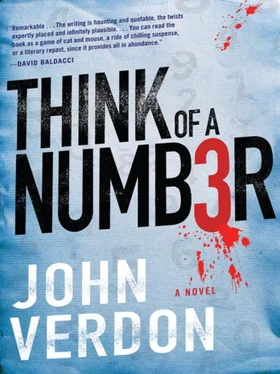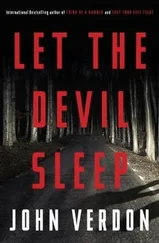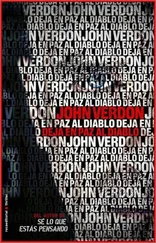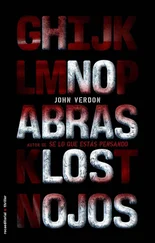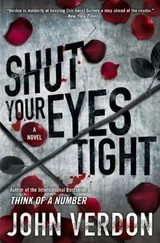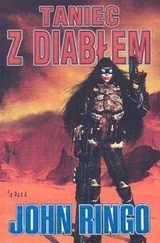Gurney wondered which approach might be prevailing at the moment.
Outside the yellow tape barrier, on the far side of the bloodstain, Jack Hardwick was giving instructions to two serious-looking young men, one of whom was the Tom Cruise wannabe who’d just delivered Gurney to the site, and the other appeared to be his twin. The nine intervening years since they worked together on the infamous Piggert case seemed to have added twice that many years to Hardwick’s age. The face was redder and fatter, the hair thinner, and the voice had developed the kind of roughness that comes from too much tobacco and tequila.
“There are twenty guests,” he was saying to the Top Gun doubles. “Each of you take nine of them. Get preliminary statements, names, addresses, phone numbers. Get verification. Leave Patty Cakes and the chiropractor to me. I’ll also talk to the widow. Check back with me by four P.M.”
More comments went back and forth among them in voices too low for Gurney to hear, punctuated by Hardwick’s grating laugh. The young man who’d escorted Gurney from the front gate said a final word, tilting his head significantly in Gurney’s direction. Then the duo set off toward the main building.
Once they were out of sight, Hardwick turned and offered Gurney a greeting halfway between a grin and a grimace. His strange blue eyes, once brightly skeptical, seemed fraught with a tired cynicism.
“I’ll be damned,” he rasped, walking around the taped area toward Gurney, “if it isn’t Professor Dave.”
“Just a humble instructor,” corrected Gurney, wondering what else Hardwick had taken the trouble to find out about his post-NYPD stint teaching criminology at the state university.
“Don’t give me that humility shit. You’re a star, my boy, and you know it.”
They shook hands without much warmth. It struck Gurney that the bantering attitude of the old Hardwick had curdled into something toxic.
“Not a lot of doubt about the location of death,” said Gurney, nodding at the bloodstain. He was eager to get to the point, brief Hardwick on what he knew, and get out of there.
“There’s doubt about everything,” proclaimed Hardwick. “Death and doubt are the only two certainties in life.” Getting no response from Gurney, he went on, “I’ll grant you there may be less doubt about the location of death than about some other things here. Goddamn loony bin. People here go on about the victim like he was that Deepdick Chopup guy on TV.”
“You mean Deepak Chopra?”
“Yeah, Dipcock or whatever. Christ, gimme a break!”
Despite the uncomfortable reaction building inside him, Gurney said nothing.
“What the hell do people come to places like this for? Listen to some New Age asshole with a Rolls-Royce talk about the meaning of life?” Hardwick shook his head at the foolishness of his fellow man-frowning at the back of the house all the while, as though eighteenth-century architecture might bear a large part of the blame.
Irritation overcame Gurney’s reticence. “As far as I know,” he said evenly, “the victim was not an asshole.”
“I didn’t say he was.”
“I thought you did.”
“I was making a general observation. I’m sure your buddy was an exception.”
Hardwick was getting under Gurney’s skin like a sharp sliver. “He wasn’t my buddy.”
“I got the impression from the message you left with the Peony police, which they kindly passed along to me, that your relationship went way back.”
“I knew him in college, had no contact with him for twenty-five years, and got an e-mail from him two weeks ago.”
“What about?”
“Some letters he got in the mail. He was upset.”
“What kind of letters?”
“Poems, mostly. Poems that sounded like threats.”
This made Hardwick stop and think before going on. “What did he want from you?”
“My advice.”
“What advice did you give him?”
“I advised him to call the police.”
“I gather he didn’t.”
The sarcasm irked Gurney, but he held his temper.
“There was another poem,” said Hardwick.
“What do you mean?”
“A poem, on a single sheet of paper, laid on the body, with a rock on it for a paperweight. All very neat.”
“He’s very precise. A perfectionist.”
“Who?”
“The killer. Possibly very disturbed, definitely a perfectionist.”
Hardwick stared at Gurney with interest. The mocking attitude was gone, at least temporarily. “Before we go any further, I need to know how you knew about the broken bottle.”
“Just a wild guess.”
“Just a wild guess that it was a whiskey bottle?”
“Four Roses, specifically,” said Gurney, smiling with satisfaction when he saw Hardwick’s eyes widen.
“Explain how you know that,” demanded Hardwick.
“It was a bit of a leap, based on references in the poems,” said Gurney. “You’ll see when you read them.” In response to the question forming on the other man’s face, he added, “You’ll find the poems, along with a couple of other messages, in the desk drawer in the den. At least, that’s the last place I saw Mellery put them. It’s the room with the big fireplace off the center hall.”
Hardwick continued staring at him as though doing so would resolve some important issue. “Come with me,” he finally said. “I want to show you something.”
He led the way in uncharacteristic silence to the parking area, situated between the massive barn and the public road, and came to a halt where it was connected to the circular driveway and where a corridor of yellow police tape began.
“This is the nearest place to the road where we can clearly distinguish the footprints we believe belong to the perp. The road and the drive were plowed after the snow stopped around two A.M. We don’t know whether the perp entered the property before or after the plowing. If before, any tracks on the road outside or on the drive would have been obliterated by the plow. If after, no tracks would have been made to begin with. But from this point right here, around the back of the barn, to the patio, across the open area to the woods, through the woods, to a pine thicket by Thornbush Lane, the tracks are perfectly clear and easy to follow.”
“No effort made to conceal them?”
“No,” said Hardwick, sounding bothered by this. “None at all. Unless I’m missing something.”
Gurney gave him a curious glance. “What’s the problem?”
“I’ll let you see for yourself.”
They walked along the yellow-taped corridor, following the tracks to the far side of the barn. The imprints, sharply indented in the otherwise featureless three-inch layer of snow, were of large (Gurney estimated size ten or eleven, D width) hiking boots. Whoever had come this way in the wee hours of the morning hadn’t cared that his route would later be noted.
As they rounded the back of the barn, Gurney saw that a wider area there had been taped off. A police photographer was taking pictures with a high-resolution camera while a crime-scene specialist in a protective white bodysuit and hair enclosure awaited his turn with an evidence-collection kit. Every shot was taken at least twice, with and without a ruler in the frame to establish scale, and objects were photographed at various focal-length settings-wide to establish position relative to other objects in the scene, normal to present the object itself, and close-up to capture detail.
The center of their attention was a folding lawn chair of the flimsy sort that might be sold in a discount store. The footprints led directly to the chair. In front of it, stamped out in the snow, were half a dozen cigarette butts. Gurney squatted to take a closer look and saw they were Marlboros. The footprints then continued from the chair around a thicket of rhododendrons toward the patio where the murder had apparently occurred.
Читать дальше
